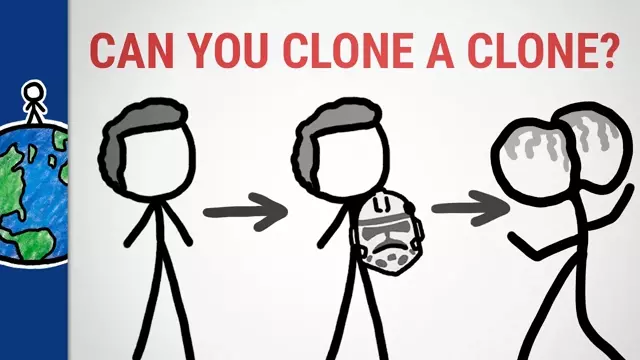2020-05-21
[public] 424K views, 15.6K likes, dislikes audio only
Sign up for your FREE trial to The Great Courses Plus here: http://ow.ly/2UGB30qCbvs.
Because of the way genetic reprogramming works, it’s hard to make one clone based on an adult cell, and it’s almost impossible to make a second-generation one.
Thanks also to our Patreon patrons https://www.patreon.com/MinuteEarth and our YouTube members.
___________________________________________
To learn more, start your googling with these keywords:
Cell: The smallest structural and functional unit of an organism.
Clone: An organism produced asexually from one ancestor, to which they are genetically identical.
DNA: Deoxyribonucleic acid, a self-replicating material that is present in nearly all living organisms as the main component of chromosomes. It is the carrier of genetic information.
Embryo: An unborn or unhatched offspring early in the process of development.
Enzyme: A substance produced by a living organism that acts as a catalyst to bring about a specific biochemical reaction.
Gene: A unit of heredity which is transferred from a parent to offspring. These are encoded within DNA and help determine traits.
Genetic Reprogramming: This refers to erasing and remodeling epigenetic marks, such as DNA methylation during mammalian development.
Zygote: A diploid cell resulting from the fusion of two haploid gametes
___________________________________________
Subscribe to MinuteEarth on YouTube: http://goo.gl/EpIDGd
Support us on Patreon: https://goo.gl/ZVgLQZ
And visit our website: https://www.minuteearth.com/
Say hello on Facebook: http://goo.gl/FpAvo6
And Twitter: http://goo.gl/Y1aWVC
And download our videos on itunes: https://goo.gl/sfwS6n
___________________________________________
Credits (and Twitter handles):
Script Writer: Cameron Duke (@dukeofcam)
Video Director, Narrator, and Script Editor: David Goldenberg (@dgoldenberg)
Video Illustrator: Arcadi Garcia Rius (@garirius)
With Contributions From: Henry Reich, Alex Reich, Kate Yoshida, Ever Salazar, Peter Reich, Julián Gómez, Sarah Berman
Music by: Nathaniel Schroeder: http://www.soundcloud.com/drschroeder
___________________________________________
References:
Chan, M. M., Smith, Z. D., Egli, D., Regev, A., & Meissner, A. (2012). Mouse ooplasm confers context-specific reprogramming capacity. Nature Genetics, 44(9), 978–980. https://doi.org/10.1038/ng.2382
Dean, W., Santos, F., & Reik, W. (2003). Epigenetic reprogramming in early mammalian development and following somatic nuclear transfer. Seminars in Cell & Developmental Biology, 14(1), 93–100. https://doi.org/10.1016/s1084-9521(02)00141-6
Evans, M. J., Gurer, C., Loike, J. D., Wilmut, I., Schnieke, A. E., & Schon, E. A. (1999). Mitochondrial DNA genotypes in nuclear transfer-derived cloned sheep. Nature Genetics, 23(1), 90–93. https://doi.org/10.1038/12696
Gao, R., Wang, C., Gao, Y., et al. (2018). Inhibition of Aberrant DNA Re-methylation Improves Post-implantation Development of Somatic Cell Nuclear Transfer Embryos. Cell Stem Cell, 23(3), 426–435.e5. https://doi.org/10.1016/j.stem.2018.07.017
Histone Deacetylase - an overview | ScienceDirect Topics. (n.d.). Www.Sciencedirect.Com. Retrieved March 2, 2020, from https://www.sciencedirect.com/topics/neuroscience/histone-deacetylase
Hochedlinger, K., & Plath, K. (2009). Epigenetic reprogramming and induced pluripotency. Development, 136(4), 509–523. https://doi.org/10.1242/dev.020867
Hochedlinger, K., Rideout, W. M., Kyba, M., Daley, G. Q., Blelloch, R., & Jaenisch, R. (2004). Nuclear transplantation, embryonic stem cells and the potential for cell therapy. The Hematology Journal, 5, S114–S117. https://doi.org/10.1038/sj.thj.6200435
Lister, R., Pelizzola, M., Kida, Y. S., et al. (2011). Hotspots of aberrant epigenomic reprogramming in human induced pluripotent stem cells. Nature, 471(7336), 68–73. https://doi.org/10.1038/nature09798
Morgan, H. D., Santos, F., Green, K., Dean, W., & Reik, W. (2005). Epigenetic reprogramming in mammals. Human Molecular Genetics, 14(suppl_1), R47–R58. https://doi.org/10.1093/hmg/ddi114
Reik, W. (2001). Epigenetic Reprogramming in Mammalian Development. Science, 293(5532), 1089–1093. https://doi.org/10.1126/science.1063443
Srivastava, D., & DeWitt, N. (2016). In Vivo Cellular Reprogramming: The Next Generation. Cell, 166(6), 1386–1396. https://doi.org/10.1016/j.cell.2016.08.055
Wakayama, S., Kohda, T., Obokata, H., et al. (2013). Successful Serial Recloning in the Mouse over Multiple Generations. Cell Stem Cell, 12(3), 293–297. https://doi.org/10.1016/j.stem.2013.01.005
Wakayama, T., Shinkai, Y., Tamashiro, K. L. K., et al. (2000). Cloning of mice to six generations. Nature, 407(6802), 318–319. https://doi.org/10.1038/35030301
Yamanaka, S. (2012). Induced Pluripotent Stem Cells: Past, Present, and Future. Cell Stem Cell, 10(6), 678–684. https://doi.org/10.1016/j.stem.2012.05.005
https://www.patreon.com/minuteearth
/youtube/channel/UCeiYXex_fwgYDonaTcSIk6w
https://patreon.com/minuteearth
/youtube/video/4DF94Wvtekk

